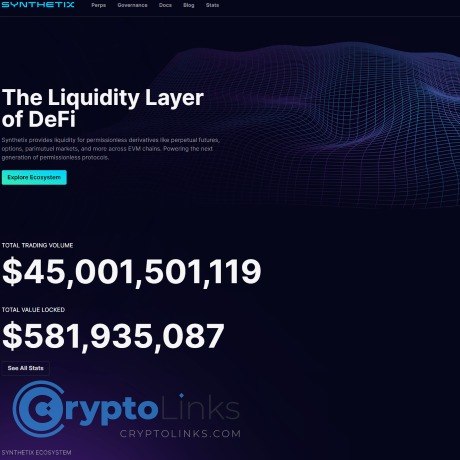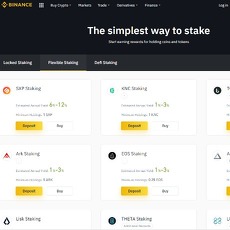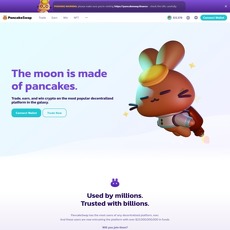Synthetix Review
Synthetix
synthetix.io
Introduction to My In-Depth Synthetix Review
As a crypto enthusiast always keeping a watchful eye on the trend, I've grown intrigued by a particular decentralized finance project, Synthetix. This project sits on the Ethereum network and enables the issuance and trading of Synthetic decentralised assets. On the surface, it seems promising, but I'm drawn to scrutinize its inner workings and safety quotient. So join me in my Synthetix review as we delve deeper into this blockchain-distributed asset issuance protocol, examine its claims, and explore its functionalities. Before diving in, let's briefly remind ourselves of the promise that cryptos offer and the evolution of the DeFi movement.
Understanding the DeFi Movement and Promise of Cryptocurrencies
The allure of cryptocurrencies lies in their promise to create universally accepted money and transaction systems. Ideally, regardless of where two parties might be in the world, they should be able to transact, with minimal fees. This vision was the foundation of Bitcoin just over a decade ago. Fast forward to now, and the landscape has evolved. The Decentralized Finance (DeFi) movement has taken that original premise further. A world where everyone can access a complete range of financial services without banks or intermediaries. From insurance products, loans, investments, savings accounts, to more – all residing on a blockchain and accessible to anyone with connectivity and an internet-capable device. Such possibilities already exist on blockchains with smart contract capabilities such as the Ethereum blockchain. These smart contracts are automatic applications that execute when certain conditions are met. By leverage, developers can enrich blockchain functionality beyond simple transaction handling.
Enter Synthetix: A DeFi Project with a Difference
One project that epitomizes this evolution is Synthetix. This DeFi project has a cryptocurrency built on the Ethereum blockchain and enables the creation of synthetic assets, imitating the price of any other asset—think currencies, equities, bonds, commodities, or cryptocurrencies. The mechanism behind Synthetix, the Synthetix perpetual futures, these smart contract-based offerings bring low trading fees and deep liquidity on a range of synthetic assets. Kain Warwick, the project’s founder, appended a new derivatives front-end called Infinex expanding the decentralized trading infrastructure.
Features of the Planned Decentralized Exchange (DEX) Infinex
The planned Decentralized Exchange(DEX) in Infinex is expected to provide features similar to centralized exchanges (CEX), easing access to both novice and seasoned traders. With a username and password, users can access Infinex while maintaining a noncustodial setup. Each user is allotted a unique public-private key pair, stored locally in the browser. However, these keys are only used to sign trades sent to the account relayer on Optimism and cannot withdraw funds.
Behind the Scenes: The Composition of Synthetix
Synthetix is an Ethereum blockchain creation and notably includes two distinct token types. The main token used in creating synthetic assets is called Synthetix and bears the ticker symbol SNX. The second token type, the Synths, represents all the synthetic assets created with the Synthetix platform. From the outside looking in, it seems straightforward. Users purchase SNX tokens and lock them up in a compatible wallet. Once the SNX tokens are locked, users can create Synths to track the value of other real-world assets. The slightly tricky part is that a Synth’s price is determined by oracles, many introduced via a partnership with Chainlink (LINK). Synths currently mainly represent currency or cryptocurrency pairs, but Synths based on gold and silver are available. All the Synths can be traded and exchanged at the Synthetix Exchange, boasting endless liquidity due to the possible creation and ownership of Synths based on different criteria.
Four unique features of Synthetix
- The ability to create and convert Synths without requiring a counterparty.
- Trades between any Synth via the Synthetix Exchange.
- Peer-to-contract (P2C) trading for fast and easy execution without an order book.
- A distributed pool of token holders providing collateral to maintain the exchange's stability.
What Can You Trade on Synthetix?
Users can currently trade major currencies like the euro, yen, pound sterling, U.S. dollar, Australian dollar, Swiss franc, and more. There are also Synths and inverse Synths of cryptocurrencies such as Bitcoin (BTC), Ethereum (ETH), Ripple (XRP), Tron (TRX), Chainlink (LINK), and others. Assets like gold and silver can also be traded via Synths and inverse Synths. However, the big picture potential of Synthetix could entail trading any financial asset. From derivatives, commodities, equities to other financial instruments painting a picture worth hundreds of trillions of dollars. If Synthetix reaches its potential, it could bring the huge traditional financial markets into a tokenized world on the Ethereum blockchain in a decentralized and permissionless manner. As such, it would reduce the friction associated with centralized financial institutions and government regulations.
Maintaining Collateralized Synthetix
The primary challenge in the Synthetix ecosystem is maintaining its collateralization. Simply put, if the SNX values and the created Synths' values move in opposite directions, how could the system retain its collateralization? Synthetix has built-in mechanisms to ensure continual functionality, regardless of the price movements of the SNX tokens and the created Synths.
- A 750% collateralization requirement: To issue a new Synth, the Synthetix system requires collateralization of 750%. This buffer effectively shields Synths in circulation from sudden market moves.
- Debt-driven system: When SNX stakers mint Synths, it takes the form of an outstanding debt on the platform.
- Debt Pools: Personal debts from each Synth creator are calculated as an ever-changing percentage of the total Synths minted and in circulation.
Synthetix Exchange: The Trading Arena
The Synthetix Exchange serves as the marketplace for buying and selling the various Synths. Because this exchange uses smart contract technology, there’s no need for reliance on any third-party in the exchange process. Anyone can engage in transactions at any time, tapping into the seemingly endless liquidity of Synthetix. Accessing the Exchange simply requires connecting an ERC-20 compatible wallet with some ETH for gas and some Synth. Current exchange fees for all assets on the Exchange stand at 0.3%.
Inflation and Staking Rewards
A unique feature of Synthetix is it's built-in inflationary mechanism. The project's developers added this inflationary component to increase incentives for minting Synths. SNX stakers receive rewards from 0.3% of each transaction executed on the Exchange. This encourages Synths issuers to issue more to enhance their earnings from staking fees.
Synthetix is leading the DeFi revolution by offering global access to synthetic assets and fostering specialized trading strategies. With a vision as grand as revolutionizing the financial markets, the Synthetix team deserves applause. However, as intriguing as the Synthetix project is, it's essential to bear in mind that it's still developing. It faces challenges tied to its reliance on Ethereum, centralization concerns, and the need for precise price feeds for synthetic assets minted and listed on the Exchange. Despite these concerns, the Synthetix project remains a captivating endeavor in the DeFi movement.
Frequently Asked Questions (FAQ)
What is Synthetix?
Synthetix is a decentralised protocol built on the Ethereum network that allows users to issue and trade synthetic decentralised assets. I can create my own synthetic assets that track the price of any other asset, be it currencies, equities, commodities, or even other cryptocurrencies.
What is the promise of Decentralised Finance (DeFi)?
The promise of DeFi is to create a type of money and transactional system that is universally accepted, with minimal fees. Its goal is to provide everyone on the planet with easy and open access to a complete range of financial services, including insurance products, loans, investments and savings accounts, without the need for banks or third-party intermediaries.
How does Synthetix work?
The main token in Synthetix is the Synthetix token (SNX). Users purchase SNX tokens and lock them in a compatible wallet. Once the SNX tokens are locked up, they can be used to create Synths to track the price of some other real-world asset. The price of each Synth is determined by oracles, many of which have been provided through a partnership with Chainlink (LINK).
What are some unique features of Synthetix?
The Synthetix platform allows anyone to create and convert Synths without the need for a counterparty. It allows for peer-to-contract (P2C) trading, and a distributed pool of token holders is responsible for providing collateral on the platform and for maintaining its stability.
What can you trade with Synthetix?
Currently, users can trade Synths and inverse Synths of major currencies, cryptocurrencies such as Bitcoin, Ethereum, Ripple, Tron, and Chainlink, as well as gold and silver. However, theoretically, any asset with real-world value can be traded using Synthetix.
How does Synthetix stay collateralized?
Syntethix keeps the system collateralized with a buffer of 750% collateralization and debt mechanisms. Each person who creates Synths carries a personal debt in the Synths they’ve minted, as well as contributing towards the global debt that underlies the entire circulation of Synths.
What are exchange fees and staking rewards in Synthetix?
Synthetix ecosystem users collect staking rewards from Synthetix Exchange fees. The reward pool for stakers expands with more usage of the Synthetix Exchange. Keep in mind, stakers can only earn and collect rewards if they keep their collateralization at or above 750%, maintaining liquidity in the system.
What is Mintr?
Mintr is an application that was created to make the minting of Synth and staking SNX as simple as possible. Users connect their ERC-20 compatible wallet to Mintr to perform a range of actions related to the Synthetix ecosystem such as minting and burning Synth, locking and unlocking SNX and more.
Who created Synthetix?
Synthetix was originally conceived and created under the name Havven in 2017 by Kain Warwick in Sydney, Australia. The team behind Synthetix is composed of industry experts with extensive experience in software engineering and blockchain technology.
What risks are associated with Synthetix?
Risks associated Synthetix include it still being in development; there is no guarantee it will grow and succeed in the long term. Synthetix’s dependence on Ethereum, its current centralization, need for reliable price feeds are also concerns. Potential future regulatory changes also pose a risk to the platform as some jurisdictions could classify Synths as securities or financial derivatives.
Do you recommend investing in Synthetix?
While Synthetix presents an intriguing use case in the DeFi sector, as with any cryptocurrency investment, potential investors should conduct their own research and consider the risks. While SNX tokens have experienced growth in value, there's still a lot of uncertainty in the long-term success of the project.
Deconstructing the Synthetix Promise
I have spent considerable time studying cryptocurrencies, tokens, blockchain, and everything DeFi. One project which has understandably sparked my interest is Synthetix. Based on Ethereum, Synthetix aims to decentralize trading by enabling the issuance of synthetic assets. In this Synthetix review, I will parse the technical details, provide perspectives on the project's safety, and detail the platform experience.
Pros of Synthetix
- Universally Accepted Synthetic Assets
The Synthetix platform allows for the creation of synthetic assets that can track the price of any real-world asset - currencies, commodities, and even other cryptocurrencies. It's a central promise of DeFi realized - creating a universally accepted type of money and transactional system.
- Infinite Liquidity and Assets
Synthetix provides seemingly infinite liquidity and allows for a massive number of different assets. The development of Synthetix perpetual futures has significantly contributed to this increase in diversity and trading capacity.
- No Need for Counterparty in Creation and Conversion
One of the unique features of Synthetix is that anybody can create and convert Synths without needing a counterparty. This functionality provides vast potential for innovative trading strategies.
- Introduction of Infinex
The founder recently introduced Infinex, a decentralized derivatives front-end feature that offers both novice and experienced traders features similar to centralized exchanges, all while maintaining a noncustodial setup.
- Earning Opportunity
By holding SNX tokens, minting Synths, and collecting staking fees, users can earn income directly from the system, creating another incentive for users.
Cons of Synthetix
- High Collateralization Requirement
A big pitfall in the system is the high collateral requirement - in order to mint a new Synth, you need to provide a collateral of 750% in SNX tokens. While this creates a buffer, it’s a steep threshold for many users.
- Complexity in Managing Synths
The system gets complex when dealing with the value of Synths. Issuers are not required to repay their debt with the exact type of Synth that was initially minted, creating inherent complexities in managing your balance.
- Dependence on Ethereum
Being built on Ethereum's network means the performance and value of Synthetix are impacted by any substantial changes on the Ethereum network, and it can suffer from Ethereum network congestion issues.
- Centralization Risks
Currently, Synthetix is quite centralized. The need for reliable price feeds through oracles like Chainlink could limit the system’s decentralization potential.
- Regulatory Uncertainties
There's a high risk of regulatory intervention in future as jurisdictions may classify the Synths as securities. This could bring about securities law implications and disrupt the operations of the platform.
- Competition Risk
There is a risk that Synthetix might face stiff competition from similar DeFi projects which could impact its positioning in the market.
Synthetix holds massive potential as a game-changer in the DeFi realm, promising robust functionalities. However, a host of intrinsic and extrinsic factors could create roadblocks. As users and investors, it’s crucial we stay informed and make educated choices in the volatile and uncertain world of cryptocurrencies. Synthetix, like other cryptocurrencies, is inherently risky – yet that is part of what makes it compelling to us crypto guys. Dive into my robust, all-encompassing review of Synthetix, an innovative DeFi project on Ethereum's network, enabling minting and trading decentralized assets. Learn about Synthetix's unique features, financial potential, and risks. A must-read for investors venturing into the DeFi space.











